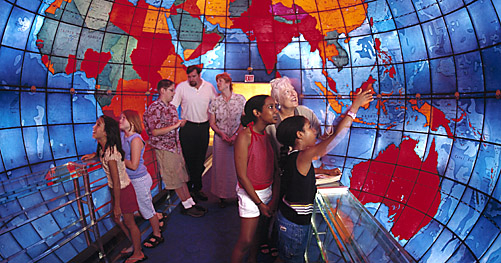 Many pre-1950 maps, globes and atlases showed Tibet as an independent nation separate from China. Some of the earliest maps on record of Asia show Tibet (variably spelled as Tobbat, Thibbet, or the Kingdom of Barantola) as separate from China or Cathay. A map of Asia drawn by the Dutch cartographer, Pietar van der Aa around 1680 shows Tibet in two parts but distinct from China;[18] as does a 1700 map drawn by the French cartographer Guillaume de L’isle, where Tibet is referred to as the “Kingdom of Grand Tibet.” [19] A map of India, China and Tibet published in the USA in 1877 represents Tibet as distinct from the two other nations.[20] An 1827 map of Asia drawn by Anthony Finley of Philadelphia, clearly shows “Great Thibet” as distinct from the Chinese Empire.[21]
Many pre-1950 maps, globes and atlases showed Tibet as an independent nation separate from China. Some of the earliest maps on record of Asia show Tibet (variably spelled as Tobbat, Thibbet, or the Kingdom of Barantola) as separate from China or Cathay. A map of Asia drawn by the Dutch cartographer, Pietar van der Aa around 1680 shows Tibet in two parts but distinct from China;[18] as does a 1700 map drawn by the French cartographer Guillaume de L’isle, where Tibet is referred to as the “Kingdom of Grand Tibet.” [19] A map of India, China and Tibet published in the USA in 1877 represents Tibet as distinct from the two other nations.[20] An 1827 map of Asia drawn by Anthony Finley of Philadelphia, clearly shows “Great Thibet” as distinct from the Chinese Empire.[21] Probably the largest stained glass globe in the world (in Boston), based on the Rand McNally 1934 map of the world, clearly shows Tibet as a separate nation.[22] (Tibet is in pink above India) Following the publication of the great atlas commissioned by the Manchu Emperor Kangxi and created by Jesuit cartographers, some European maps in the mid-1700s began to depict Tibet as part of China. The Jesuits could not personally survey Tibet (as they had surveyed China and Manchuria) since Tibet was not part of the Chinese Empire. So they trained two Mongol monks in Beijing and sent them to make a secret survey of Tibet. Similar clandestine surveys of Tibet were conducted by British mapmakers using trained Himalayan natives and even a Mongol monk. An American sinologist has observed that, like European colonial powers, China could be said to have used cartography to further its “Colonial Enterprise” in Tibet and Korea.[23]
Following the publication of the great atlas commissioned by the Manchu Emperor Kangxi and created by Jesuit cartographers, some European maps in the mid-1700s began to depict Tibet as part of China. The Jesuits could not personally survey Tibet (as they had surveyed China and Manchuria) since Tibet was not part of the Chinese Empire. So they trained two Mongol monks in Beijing and sent them to make a secret survey of Tibet. Similar clandestine surveys of Tibet were conducted by British mapmakers using trained Himalayan natives and even a Mongol monk. An American sinologist has observed that, like European colonial powers, China could be said to have used cartography to further its “Colonial Enterprise” in Tibet and Korea.[23]
No comments:
Post a Comment